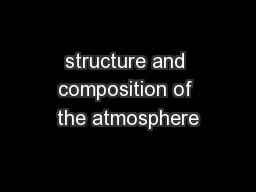

Objectives Describe the composition of Earths atmosphere Explain why air pressure changes with altitude Explain how air temperature changes with atmospheric composition Describe the layers of the atmosphere ID: 603508
Download Presentation The PPT/PDF document "structure and composition of the atmosph..." is the property of its rightful owner. Permission is granted to download and print the materials on this web site for personal, non-commercial use only, and to display it on your personal computer provided you do not modify the materials and that you retain all copyright notices contained in the materials. By downloading content from our website, you accept the terms of this agreement.
Slide1
structure and composition of the atmosphereSlide2
Objectives
Describe the composition of Earth’s atmosphere.
Explain why air pressure changes with altitude.
Explain how air temperature changes with atmospheric composition.
Describe the layers of the atmosphere.Slide3
What is the Atmosphere?
View of the atmosphere from the space shuttle
The
atmosphere
is a mixture of gases surrounding EarthSlide4
Composition of the Atmosphere
Nitrogen (78%), the most common atmospheric gas, is released when dead plants and dead animals break down and also when volcanoes erupt.
Oxygen (21%), the second most common atmospheric gas, is made by producers.
The remaining 1% of the atmosphere is made up of argon, carbon dioxide, water vapor and other gases.Slide5
Atmospheric Pressure
Atmospheric pressure is the amount of force or pressure exerted by the atmosphere on the objects located within it.
When it is pressing down with more force, we say that it is a high pressure.
When the atmosphere presses in with less force, we say that there is a low pressure in the area.Slide6
Atmospheric Pressure
The atmosphere is held around the Earth by gravity.
Gravity pulls gas molecules in the atmosphere toward the Earth’s surface, causing air pressure.
As altitude increases, the force of gravity decreases and so air pressure decreases.Slide7
Atmosphere & Temperature
Differences in atmospheric temperatures are
the
result of the
way solar energy is absorbed by the different gases present and the density of those gases.
As the altitude increases the number of air molecules decreases, thus the average of their kinetic energy decreases. The results is a decrease in air temperature with an increase of altitude
.Slide8
Layers of the Atmosphere
The Earth’s atmosphere is divided into four layers based on
temperature
.
The name of each layer gives you clues about its features:
Troposphere
(
tropo
= turning or change)
Stratosphere
(
strato
= layer)
Mesosphere
(
meso
= middle)
Thermosphere
(
thermo
= heat)Slide9Slide10Slide11
Troposphere
Lowest layer of the atmosphere, from Earth’s surface to about 10 km above.
Temperature decreases with altitude.
Contains almost 90% of the atmosphere’s mass.
Nearly all weather occurs in this layer.
The zone known as the
tropopause
represents the upper boundary of the troposphere.Slide12
Stratosphere
The atmospheric layer above the troposphere.
Lower stratosphere is extremely cold, but temperature increases as altitude increases in the stratosphere.
Rises because
ozone
, (O
3
), in the stratosphere absorbs UV radiation from the sun, warming the air
protects life on Earth.Slide13
Stratosphere
This increase in temperature with height means warmer air is located above cooler air. This is the reason for the 'anvil-shaped' tops of cumulonimbus clouds.
The zone known as the
stratopause
represents the upper boundary of the stratosphere.
Slide14
Mesosphere
The middle layer of the atmosphere.
From 50km-80km above the earth’s surface.
Coldest layer.
Temperature decreases as altitude increases, just like the troposphere.
Meteorites
and space dust burn up in this layer.
The zone known as the
mesopause
represents the upper boundary of the mesosphere.Slide15
Thermosphere
Uppermost atmospheric layer.
From 80km – 480km above the earth’s surface.
Temperature again increases steadily with altitude because nitrogen and oxygen atoms absorb solar radiation.
Contains a special part called the
ionosphereSlide16
Temps in the Troposphere & Thermosphere
Although the thermosphere has very high temperatures, IT DOES NOT FEEL HOT.
Heat is different from temperature.
Heat IS energy, which is about particles in MOTION.
Temperature is a MEASURE of the average energy in substance.
Heat energy depends on the speed, size and type of particle. Temperature does not.
For example, the temperature of a small cup of water might be the same as the temperature of a large tub of water, but the tub of water has more heat because it has more water and thus more total thermal energy.Slide17
Troposphere
ThermosphereSlide18
Ionosphere
The lower part of the thermosphere
Defined based on electrical characteristics within the thermosphere
absorbs cosmic rays, gamma rays, X-rays, some UV rays
contains ions: charged electrical particles
visible light is emitted when ions are bombarded by cosmic radiation
produce aurora borealis, aurora
australis
Slide19
Review
Why does temperature decrease with altitude in the troposphere?
Why does temperature
increase with
altitude in the
stratosphere? Why does temperature decrease with altitude in the
mesosphere?